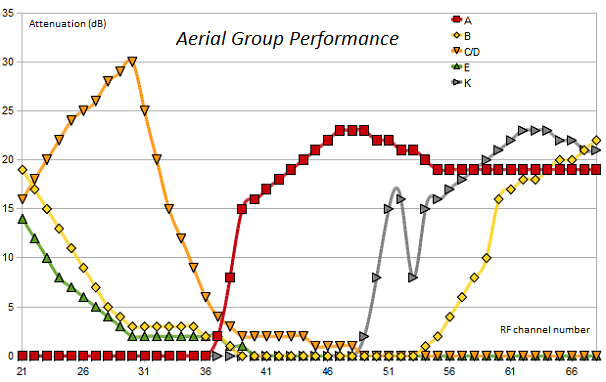Aerial group performance
 Brian Butterworth published on UK Free TV
Brian Butterworth published on UK Free TV Whilst developing the new reception prediction system, I went looking for the reference material relating to the UK Aerial Groups system.
On page 39 of a document entitled "CH61 & 62 Re-Farming Study by Arqiva Final Report 27 October 2008" I found the answers.
To assess the loss of coverage as a result of moving outside of the receive aerial group, account needs to be taken of the performance of receive aerials.
For planning purposes the UKPM assumes that the gain of a receive aerial system is 7dB. This is a somewhat idealised figure based on a good aerial and feeder and no pre-amplifier. The performance of actual receive installations is known to vary considerably from this ideal. Two studies, one for the Virgin consortium that bid for the Channel 5 licence in 1995 and the other for the ITC in 2004 investigated the actual received level for a large sample of domestic installations. This study considered aerial group but not the performance of actual receive installations.
In addition to variability in receive aerial system gain, most aerials are banded and their performance falls away outside their design operating band. The ITC as part of the documentation for the original DTT plan, Notes for applicants on coverage of Digital Television, October 1996, listed the out of group response of representative receive aerials.
I have reproduced the information from the table as a graph. The values are the attenuation (in dB):

It is interesting to note that in group A, C37 is -2dB and "in group", group B, C35 is -3dB and C36 is -2dB and "in group", group C/D has C48 on -1dB and "in group" and group E has C37 or -2dB and C38 and C39 on -1dB and be "in group".
5:20 PM
Malcolm Campbell: Because 2,200 homes won't give the commercial broadcasters enough extra viewers to make the cost of providing their channels worthwhile. There are around 80 full service Freeview transmitters which broadcast the main 6 multiplexes and cover around 90% of UK households. To reach 99% coverage of the 3 PSB muxes requires over 1,000 additional transmitters so it just wouldn't be profitable for the commercial broadcasters to expand their coverage further. If you want more channels look at getting Freesat, which nowadays has nearly all of the channels available on Freeview plus various others for a one off cost and no ongoing subscription.
| link to this comment |
If you want to check your aerial will continue to cover sufficient bandwidth to continue to receive future freeview transmissions, the proposed transmitter freq's / channel nos. and their powers can be downloaded from Ofcom's transmitter freq. info page:
UK digital television transmitter details - Ofcom
see section on "Post-700 MHz Clearance transmitter network"
Link to full spreadsheet of proposed transmitter freqs:
https://www.ofcom.org.uk/…xlsx
John Honneyman.
| link to this comment |
8:29 AM
john honneyman:
The simplest way is to ensure you have a wideband aerial fitted. That will cover sll the possible channels to be used by all transmitters.
| link to this comment |